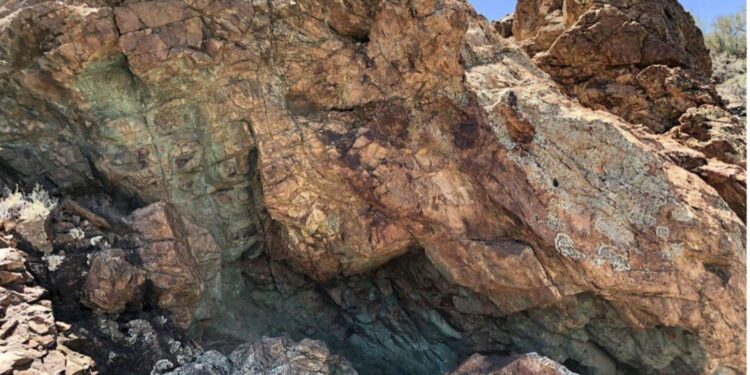New World Resources Limited (ASX:NWC) has obtained encouraging results from an initial surface geochemistry sampling programme undertaken along strike from its 100%-owned Antler Copper Deposit in northern Arizona, USA.
The mineralisation at the Antler Copper Deposit is of the volcanogenic massive sulphide (VMS) geological style. VMS deposits typically occur in clusters, so the Company has been cognisant of the potential to discover additional mineralisation along strike from the Antler Deposit.
This potential is supported by the fact that multiple mineral occurrences and prospects have previously been identified and mapped along strike from the Antler Copper Deposit. These occurrences include the small Copper World VMS deposit – located on privately-owned land approximately 5km to the north-east of the Antler Deposit.
Since acquiring the Antler Project in March 2020, all of the Company’s drilling has been completed over just 700m of strike. This is entirely because of the exceptional success the Company has continually achieved as it has drilled deeper and deeper at the Antler Deposit itself.
Notwithstanding the potential to continue to discover more mineralisation at depth at the Antler Deposit, the Scoping Study completed recently clearly demonstrated the considerable value that might be generated through further exploration success.
Accordingly, New World has started to evaluate the exploration potential along-strike from the Antler Deposit itself, as the discovery of additional mineralisation along strike may also help extend the life of operations and/or warrant increased production rates in future – both of which would likely enhance the value of the Project.
“Geologically, where there is one VMS deposit – such as Antler – there are often two, and sometimes more, all in close proximity to each other,” Managing Director and CEO, Mike Haynes, said.
“In light of this, we are very excited to have received very encouraging results from first-pass soil geochemistry sampling that covered more than 6km of the strike extensions of the geological sequence that hosts the Antler Deposit.
“The Scoping Study we completed recently clearly demonstrated that considerable value could be generated by discovering and mining additional mineralisation and processing it through the stand-alone facility that we are targeting building. Extending the operation’s life and/or increasing production rates could therefore make the Project’s economics look even more attractive.
“So, to be delineating new, high-quality exploration targets, from our very first phase of exploration work along strike from the Antler Deposit, is very encouraging. We have engaged a geophysical contractor to conduct IP surveying over these targets as soon as possible, in advance of initial drill-testing, which we plan to undertake later this year.”
Soil Geochemistry Sampling Programme
The company has now completed a soil sampling programme covering the along-strike extensions of the geological sequence that hosts the Antler Deposit. Approximately 390 samples were collected on nominal 150m x 50m (over and around the Antler Deposit) and 200m x 50m (to the east and NE of the Antler Deposit) grids.
Three very-high priority anomalies have been delineated, namely:
1. Strong Soil Anomalism directly over and to the south of the Antler Deposit
Strong coincident copper and zinc anomalism has been delineated directly over the Antler Deposit itself. Notably this anomalism extends over >1,000m of strike – whereas New World has, to date, only drill-tested the northern 700m of this anomalism. The soil geochemistry anomalism, together with previously defined coincident magnetic anomalism that also extends over >1,000m of strike, continues to highlight the potential to discover additional mineralisation immediately to the south of the known mineralisation at the Antler Deposit.
2. The “Antler Offset” Soil Anomaly
Historically the northern end of the Antler Deposit has been mapped to be offset several hundred metres to the east by a southeast-northwest trending fault. A strong 1,000m-long zinc anomaly with a coincident strong 500m-long copper anomaly has been delineated within this area (max. assays 146ppm Cu and 190ppm Zn). The southern parts of these anomalies coincide directly with mapped outcropping mineralisation. Accordingly, this is regarded as a very high- priority target for further exploration.
3. The “Copper Knob” Soil Anomaly
A strong, 700m-long copper soil geochemistry anomaly has been delineated three km to the north-east of the Antler Deposit (max. assay 305ppm Cu). Substantial copper-oxide mineralisation over tens of metres in length and up to several metres in width has been identified during initial field reconnaissance within this area. Schistose phyllite sediments host the mineralisation here – similar rocks to those that host the Antler Deposit. Locally these rocks are strongly silicified, hematite-stained and strongly clay-altered.
No drilling has been undertaken previously to test this sizeable target, hence it too is regarded as a very high-priority target for further work.
For further information please visit: https://newworldres.com/












